Mayr E.W., Pr?mel H.J., Steger A. (eds.) Lectures on Proof Verification and Approximation Algorithms
Подождите немного. Документ загружается.

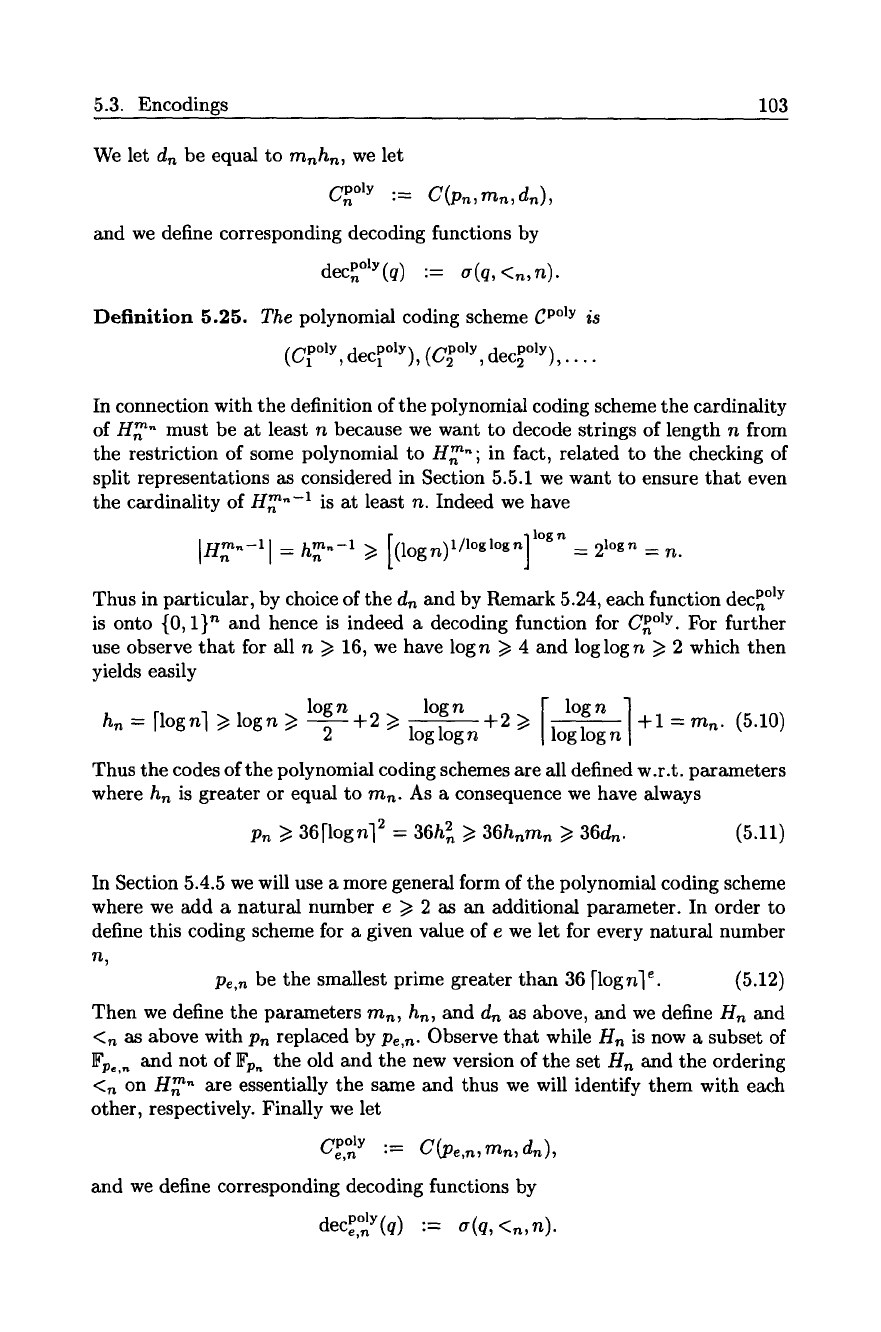
5.3. Encodings 103
We let dn be equal to mnhn, we let
C p~ ::
C(pn,mn,dn),
and we define corresponding decoding functions by
decP~ := a(q,<n,n).
Definition 5.25. The polynomial coding scheme
C p~
i8
(pp
oly ,4~poly~ ,,/-~poly
decPOly),
"1 ' ~I /, ~,~'2 , ....
In connection with the definition of the polynomial coding scheme the cardinality
of H~- must be at least n because we want to decode strings of length n from
the restriction of some polynomial to H~"; in fact, related to the checking of
split representations as considered in Section 5.5.1 we want to ensure that even
the cardinality of Hn m"- 1 is at least n. Indeed we have
9 -n ) logn) = 21ogn = n.
Thus in particular, by choice of the dn and by Remark 5.24, each function dec p~
is onto {0, 1} n and hence is indeed a decoding function for C p~ For further
use observe that for all n >/16, we have log n >1 4 and log log n >~ 2 which then
yields easily
logn logn r logn ]
hn = [logn] >/logn/> --~-+2 >t loglog----~+2 >t |log-~gn_ +1 = mn. (5.10)
Thus the codes of the polynomial coding schemes are all defined w.r.t, parameters
where hn is greater or equal to ran. As a consequence we have always
Pn >I 36[logn] 2 = 36h 2/> 36hnrnn ~ 36d~. (5.11)
In Section 5.4.5 we will use a more general form of the polynomial coding scheme
where we add a natural number e/> 2 as an additional parameter. In order to
define this coding scheme for a given value of e we let for every natural number
n,
Pr be the smallest prime greater than 36 [log n]e. (5.12)
Then we define the parameters mn, hn, and dn as above, and we define H~ and
<~ as above with Pn replaced by Pe,n. Observe that while Hn is now a subset of
Fp~., and not of Fp, the old and the new version of the set Hn and the ordering
<n on H m" are essentially the same and thus we will identify them with each
other, respectively. Finally we let
Cpoly "- C(p~,.,m.,d.),
e~n .-
and
we define corresponding decoding functions by
deceP,~ := a(q,<n,n).
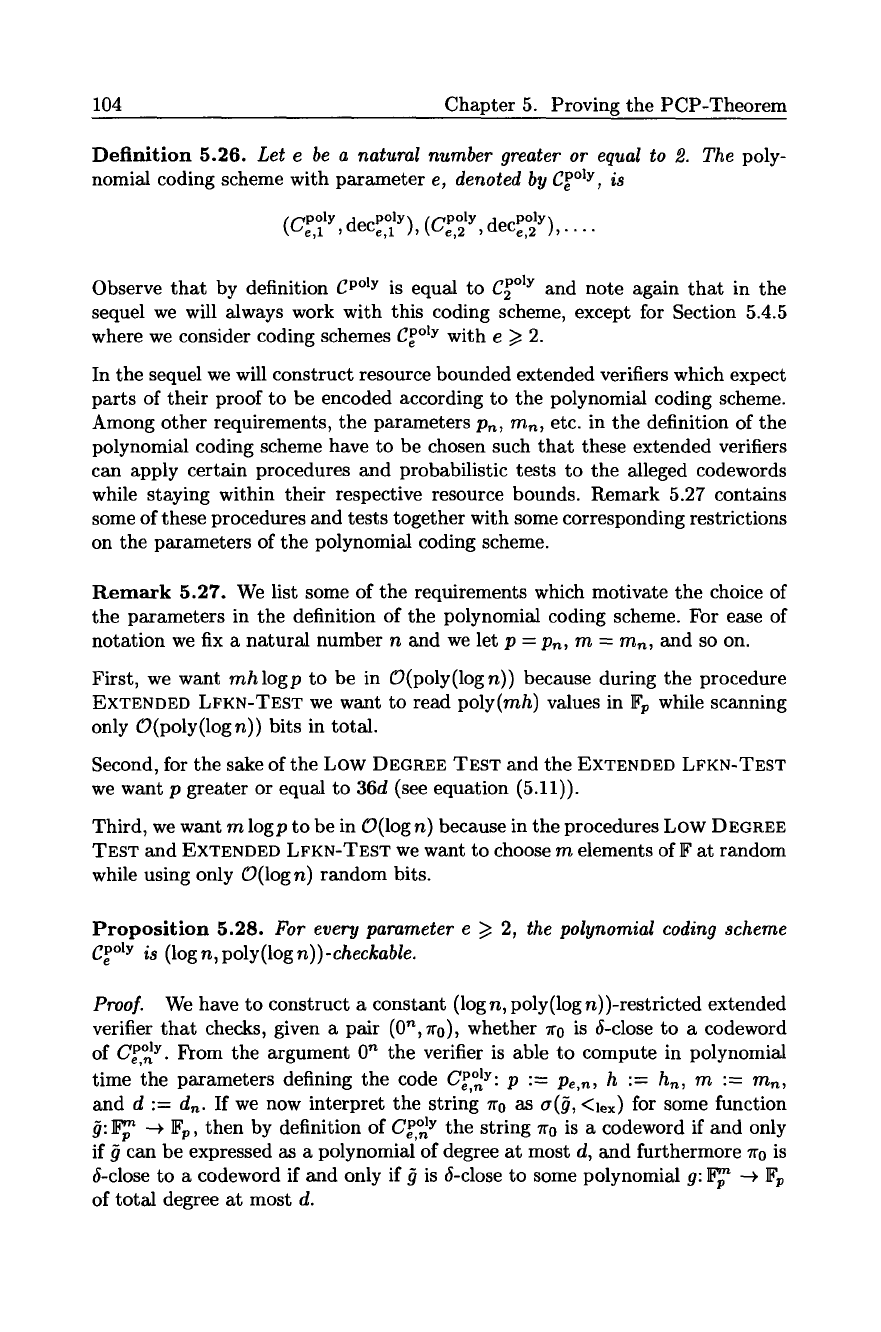
104 Chapter 5. Proving the PCP-Theorem
Definition
5.26.
Let e be a natural number greater or equal to 2. The
poly-
nomial coding scheme with parameter e,
denoted by/~poly is
v e
(fTpoly r ,,~poly
decp~y),
"-'e,1 ' "*~'t'e,1 }, kt" e,2 , , ....
Observe that by definition
C p~
is equal to gpoly and note again that in the
sequel we will always work with this coding scheme, except for Section 5.4.5
where we consider coding schemes gpoly with e/> 2.
In the sequel we will construct resource bounded extended verifiers which expect
parts of their proof to be encoded according to the polynomial coding scheme.
Among other requirements, the parameters
Pn, ran,
etc. in the definition of the
polynomial coding scheme have to be chosen such that these extended verifiers
can apply certain procedures and probabilistic tests to the alleged codewords
while staying within their respective resource bounds. Remark 5.27 contains
some of these procedures and tests together with some corresponding restrictions
on the parameters of the polynomial coding scheme.
Remark 5.27. We list some of the requirements which motivate the choice of
the parameters in the definition of the polynomial coding scheme. For ease of
notation we fix a natural number n and we let p =
Pn, m = ran,
and so on.
First, we want
mh
logp to be in O(poly(log n)) because during the procedure
EXTENDED LFKN-TEST we want
to
read poly(mh) values in Fp while scanning
only O(poly(log n)) bits in total.
Second, for the sake of the Low DEGREE TEST and the EXTENDED LFKN-TEST
we want p greater or equal to 36d (see equation (5.11)).
Third, we want m logp to be in O(log n) because in the procedures Low DEGREE
TEST and EXTENDED LFKN-TEST we want to choose m elements of F at random
while using only O(log n) random bits.
Proposition
5.28.
For every parameter e >1 2, the polynomial coding scheme
ge p~
is
(logn,
poly(logn))-checkable.
Proo].
We have to construct a constant (log n, poly(log n))-restricted extended
verifier that checks, given a pair (0a,Tro), whether 7r0 is ~-close to a codeword
of CeP,~ y. From the argument O n the verifier is able to compute in polynomial
time the parameters defining the code CeP,~Y:
p := Pe,n, h := hn, m := mn,
and d := dn. If we now interpret the string ro as a(~, <lex) for some function
~: ~ ~ Fp, then by definition of CeP,~Y the string 7to is a codeword if and only
if .~ can be expressed as a polynomial of degree at most d, and furthermore ro is
b-close to a codeword if and only if ~ is ~-close to some polynomial g: ~p ~ Fp
of total degree at most d.

5.3. Encodings 105
Thus we see that the main part of the problem consists of checking whether a
given m-ary function over a finite field Fp is &close to some polynomial of degree
d. Since d is typically small compared to p, this problem is usually called the "Low
Degree Test". (Note that using Lagrange interpolation, every m-ary function over
Fp can be written as polynomial of total degree
mp;
thus the problem is only
interesting for d <
rap.)
Note that the problem is made especially difficult by the
constraints we have to obey: We are only allowed to use O(log n) random bits,
and to check only a constant number of segments of 7r0 of length O(poly(log n)).
Observe that such a segment might contain up to O(poly(logn)) symbols of
a codeword in C~,~ y, because coding a single symbol from the corresponding
alphabet Fp requires [logpem] bits, that is O(loglogn) bits.
On the other hand, the verifier is allowed to use an additional string 7rl containing
information that could help with the decision. How could this information be
used? The basic idea of the low degree test is to note that if ~ is indeed a
m-variate polynomial of degree d over Fp, then for each x, h E ~ the function
t ~ ~(x+th)
is a univariate polynomial of degree d. Since the set
{x+th] t
9 ]~p}
can be geometrically interpreted as the line
l~,h
with slope h through the point
x, we will call this function the restriction of ~ to the line
l~,h.
In fact, it can
be shown that the converse statement holds as well: If the restrictions of ~ to
all lines can be written as polynomials with degree at most d, then ~ has total
degree at most d as well (see Lemma 5.67).
We will now use this fact to fix our interpretation of ul. If we suppose that
as encoded by lr0 is indeed a degree d polynomial, then all restrictions of ~ to
some line
i~,h are
polynomials of degree d which can be represented by their
coefficients: d + 1 elements of Fp. The verifier shall now expect 7h to contain
a table T that has one element
T(x, h)
for each x, h 9 l~p such that
T(x, h)
consists of the coefficients
T(x,
h)i 9 Fp for 1 ~ i ~< d + 1 of the polynomials
d
P~,h(t) := ~-~ T(x, h),+l " t'.
i----0
The verifier will now try to ensure that those polynomials are indeed the restric-
tions of .~ to the lines
lx,h.
Note that the table T will he coded into the string
~1 in such a way that the coefficients
T(x,h)i, 1 <. i <. d +
1, will immediately
follow each other. Thus the lookup of one polynomial
T(x, h)
can be done by
reading one segment of length
O(dlogp)
= O(poly(logn)) of 7rl, which means
our verifier is allowed to use a constant number of such table entries.
The basic operation of the verifier will now be to check whether the table T does
indeed contain "correct" polynomials/5,,h that agree with the function ~. This
is done by choosing random x, h 9 ~ and t 9 Fp, and verifying that
= + th).
One such check obviously uses
O(m
log p) = O(log n) random bits, and queries
one value of ~ and one entry of T. As noted above, this does not violate our
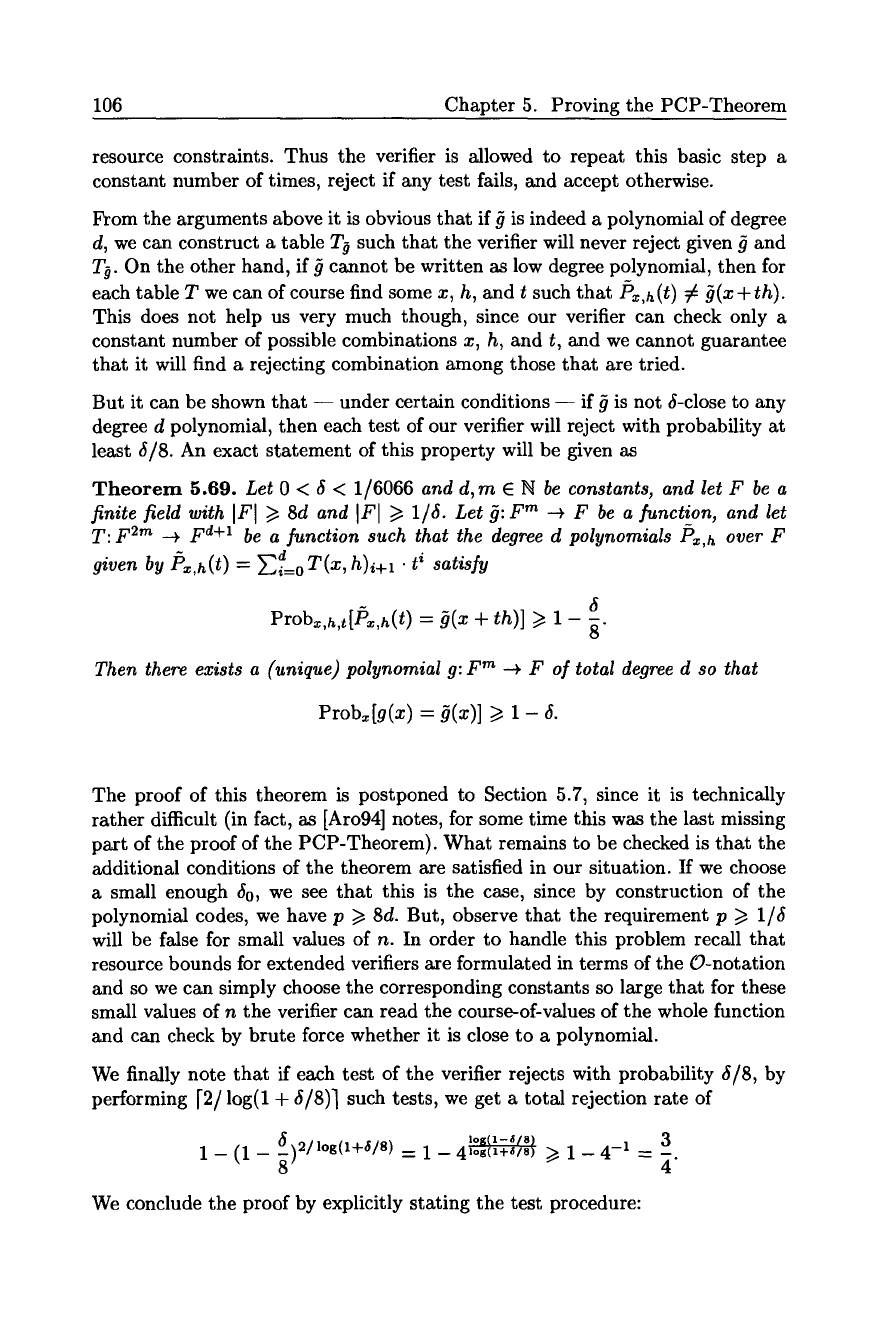
106 Chapter 5. Proving the PCP-Theorem
resource constraints. Thus the verifier is allowed to repeat this basic step a
constant number of times, reject if any test fails, and accept otherwise.
Prom the arguments above it is obvious that if 9 is indeed a polynomial of degree
d, we can construct a table T9 such that the verifier will never reject given 9 and
Tg. On the other hand, if 9 cannot be written as low degree polynomial, then for
each table T we can of course find some x, h, and t such that Px,h(t) 7 t ~(x+th).
This does not help us very much though, since our verifier can check only a
constant number of possible combinations x, h, and t, and we cannot guarantee
that it will find a rejecting combination among those that are tried.
But it can be shown that -- under certain conditions -- if 9 is not &-close to any
degree d polynomial, then each test of our verifier will reject with probability at
least 5/8. An exact statement of this property will be given as
Theorem 5.69. Let 0 < & < 1/6066 and d, m E N be constants, and let F be a
finite field with IF{ /> 8d and IF I >~ 1/5. Let ~: F m --+ F be a function, and let
T: F 2m ~ F d+l be a function such that the degree d polynomials Px,h over F
given by P~,h(t) = )-~d= o T(x, h),+l" t i satisfy
Probx,h,t[P~,h(t) = [?(x + th)] >1 1 - 5_.
8
Then there exists a (unique) polynomial g: F m --+ F of total degree d so that
Probx[g(x) = 9(x)] ~> 1 - 5.
The proof of this theorem is postponed to Section 5.7, since it is technically
rather difficult (in fact, as [Aro94] notes, for some time this was the last missing
part of the proof of the PCP-Theorem). What remains to be checked is that the
additional conditions of the theorem are satisfied in our situation. If we choose
a small enough 50, we see that this is the case, since by construction of the
polynomial codes, we have p >/8d. But, observe that the requirement p ~> 1/5
will be false for small values of n. In order to handle this problem recall that
resource bounds for extended verifiers are formulated in terms of the O-notation
and so we can simply choose the corresponding constants so large that for these
small values of n the verifier can read the course-of-values of the whole function
and can check by brute force whether it is close to a polynomial.
We finally note that if each test of the verifier rejects with probability 5/8, by
performing [2/log(1 + ~/8)~ such tests, we get a total rejection rate of
1 - (1
- ~)2/log(1T&/8) =
1 - 4~ /> 1 - 4 -1 3
8"
=4"
We conclude the proof by explicitly stating the test procedure:
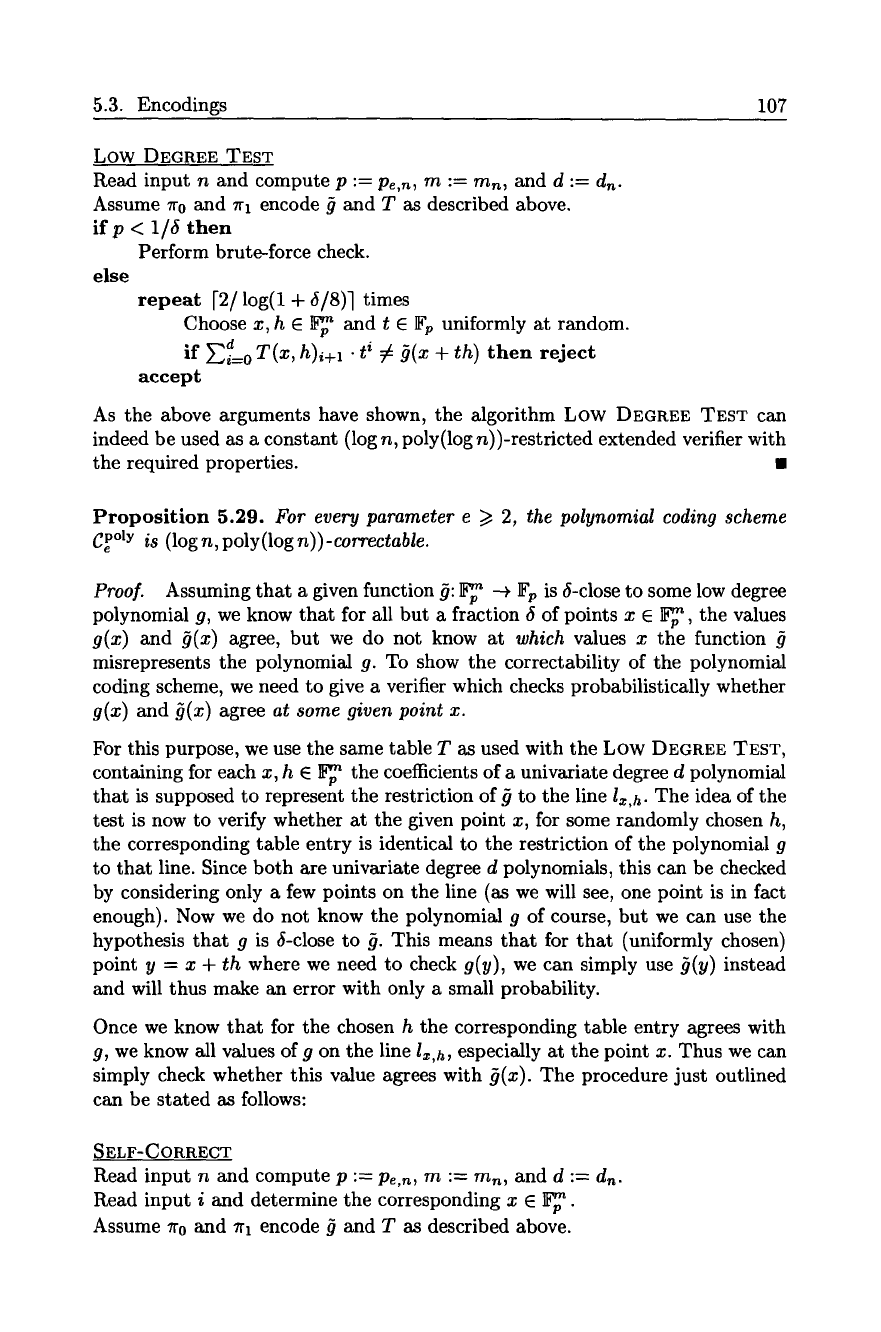
5.3. Encodings 107
Low DEGREE TEST
Read input n and compute p :-- Pe,,~, m := ran, and d :-- d,~.
Assume 7r0 and 7rl encode ~ and T as described above.
if p < 1/5 then
Perform brute-force check.
else
repeat
r2/log(1 -t- 5/8)1 times
Choose x, h E F~p and t E Fp uniformly at random.
if ~d=o T(x, h)i+l 9 t ~ ~t [l(x + th) then reject
accept
As the above arguments have shown, the algorithm Low DEGREE TEST Can
indeed be used as a constant (log n, poly(log n))-restricted extended verifier with
the required properties. 9
Proposition
5.29. For every parameter e >1 2, the polynomial coding scheme
Ce p~ is (logn, poly(logn))-correctable.
Proof. Assuming that a given function ~: F~p --~ Fp is 5-close to some low degree
polynomial g, we know that for all but a fraction 5 of points x E F~p, the values
g(x) and ~(x) agree, but we do not know at which values x the function
misrepresents the polynomial g. To show the correctability of the polynomial
coding scheme, we need to give a verifier which checks probabilistically whether
g(x) and ~(x) agree at some given point x.
For this purpose, we use the same table T as used with the Low DEGREE TEST,
containing for each x, h E ~ the coefficients of a univariate degree d polynomial
that is supposed to represent the restriction of ~ to the line Ix,a. The idea of the
test is now to verify whether at the given point x, for some randomly chosen h,
the corresponding table entry is identical to the restriction of the polynomial g
to that line. Since both are univariate degree d polynomials, this can be checked
by considering only a few points on the line (as we will see, one point is in fact
enough). Now we do not know the polynomial g of course, but we can use the
hypothesis that g is 5-close to ~. This means that for that (uniformly chosen)
point y = x + th where we need to check g(y), we can simply use ~(y) instead
and will thus make an error with only a small probability.
Once we know that for the chosen h the corresponding table entry agrees with
g, we know all values ofg on the line i~,a, especially at the point x. Thus we can
simply check whether this value agrees with .~(x). The procedure just outlined
can be stated as follows:
SELF-CORRECT
Read input n and compute p :-- Pe,n, m := ran, and d := dn.
Read input i and determine the corresponding x E F~np.
Assume ~r0 and 7ri encode ~ and T as described above.
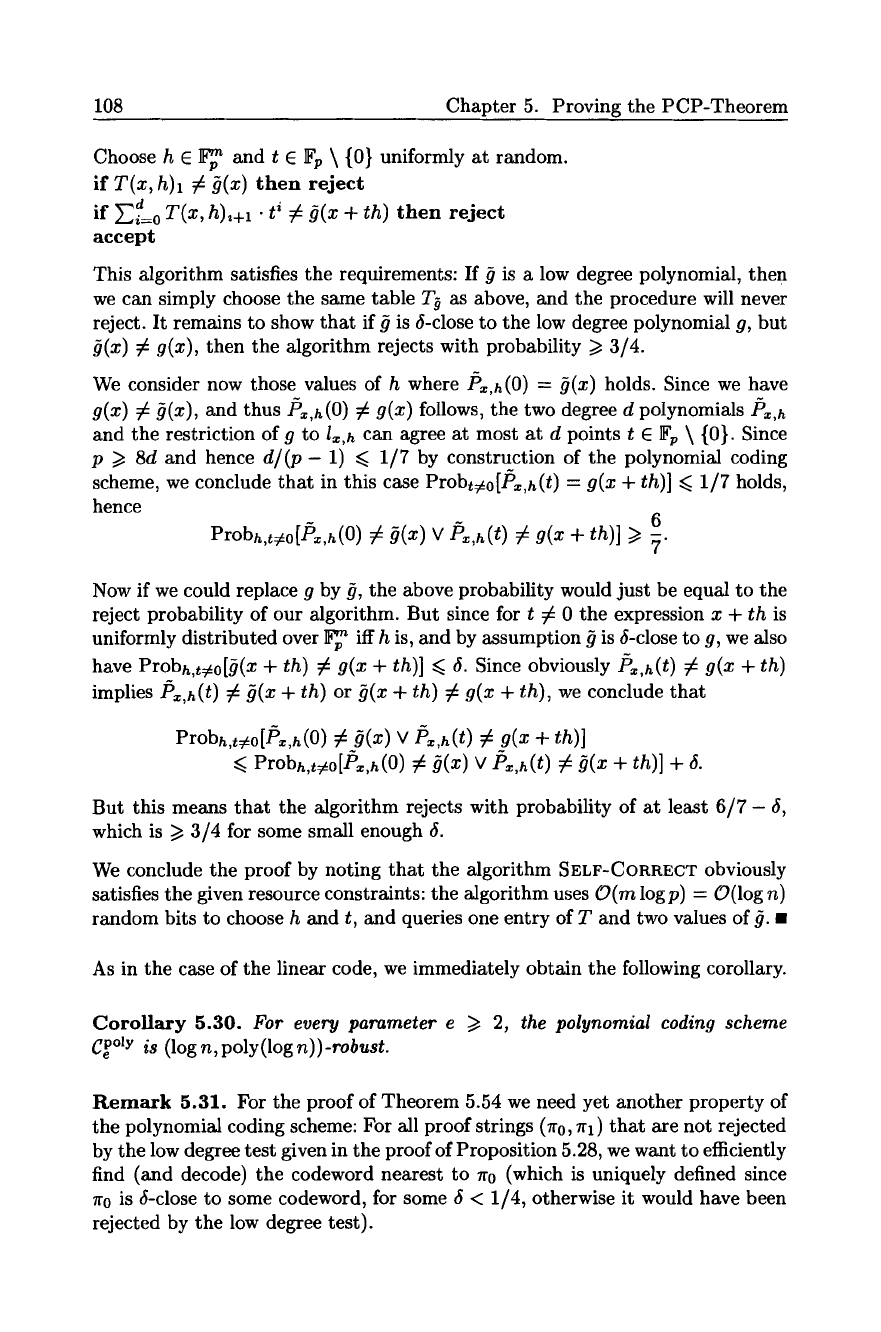
108 Chapter 5. Proving the PCP-Theorem
Choose h E F~v and t e Fp \ {0} uniformly at random.
if
T(x, h)l # it(x)
then reject
d t~
if
~i=o T(x, h),+l 9 ~ ~(x + th)
then reject
accept
This algorithm satisfies the requirements: If ~ is a low degree polynomial, then
we can simply choose the same table T~ as above, and the procedure will never
reject. It remains to show that if ~ is (i-close to the low degree polynomial g, but
~t(x) # g(x),
then the algorithm rejects with probability/> 3/4.
We consider now those values of h where /5,,h(0) = ~(x) holds. Since we have
g(x)
# ~(x), and thus/5,,h(0) #
g(x)
follows, the two degree d polynomials
fiz,h
and the restriction of g to
Iz,h
can agree at most at d points t E Fp \ {0}. Since
p /> 8d and hence
d/(p -
1) ~< 1/7 by construction of the polynomial coding
scheme, we conclude that in this case
Probt#o[[~,,h(t) = g(x + th)] <<,
1/7 holds,
hence 6
Probh,t#O[fiz,h(O) ~ ~I(X) V Pz,h(t) ~ g(x + th)] >/ ~.
Now if we could replace g by ~, the above probability would just be equal to the
reject probability of our algorithm. But since for t ~ 0 the expression
x + th
is
uniformly distributed over F~p iff h is, and by assumption ~ is (f-close to g, we also
have Probh,tr
+ th) ~ g(x + th)] <~ 5.
Since obviously
Pz,h(t)
~ g(x q- th)
implies
[3x,h(t )
~ ~(X -t- th)
or
~(x + th) r g(x + th),
we conclude that
Probh,tr • ~(X) V
P,,h(t) # g(x + th)]
~< Probh,t#o[Px,h(0) # ~(x) V
Px,h(t) # ~(x + th)] + (i.
But this means that the algorithm rejects with probability of at least 6/7 - 5,
which is >t 3/4 for some small enough (i.
We conclude the proof by noting that the algorithm
SELF-CORRECT
obviously
satisfies the given resource constraints: the algorithm uses
O(m
log p) = O(log n)
random bits to choose h and t, and queries one entry of T and two values of ~. 9
As in the case of the linear code, we immediately obtain the following corollary.
Corollary 5.30.
For every parameter e >1 2, the polynomial coding scheme
Ce p~
is
(log n, poly (log
n)) -robust.
Remark 5.31. For the proof of Theorem 5.54 we need yet another property of
the polynomial coding scheme: For all proof strings (u0, ~1) that are not rejected
by the low degree test given in the proof of Proposition 5.28, we want to efficiently
find (and decode) the codeword nearest to ~o (which is uniquely defined since
~r0 is (i-close to some codeword, for some 5 < 1/4, otherwise it would have been
rejected by the low degree test).
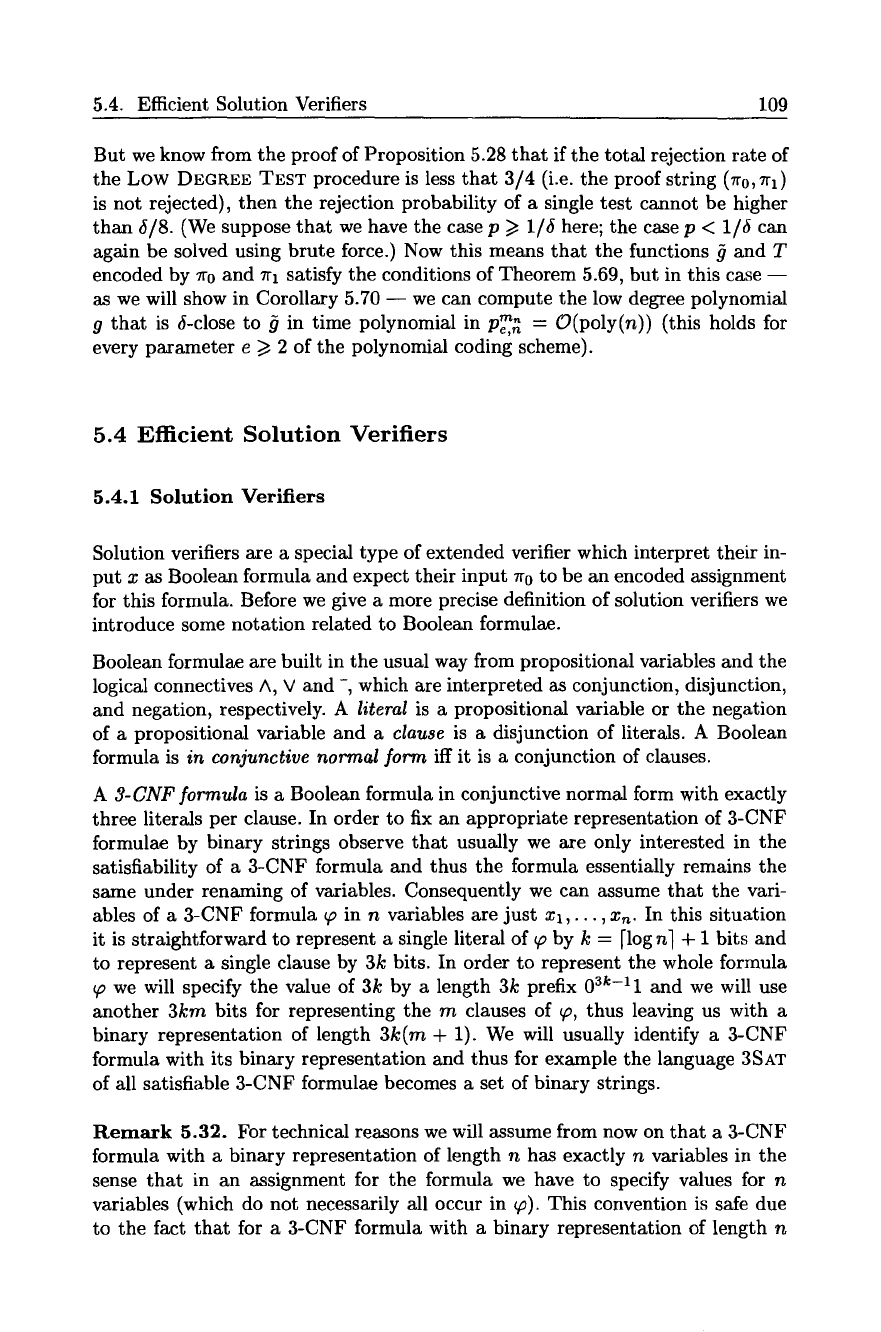
5.4. Efficient Solution Verifiers 109
But we know from the proof of Proposition 5.28 that if the total rejection rate of
the Low DEGREE TEST procedure is less that 3/4 (i.e. the proof string (uo, ~rl)
is not rejected), then the rejection probability of a single test cannot be higher
than 5/8. (We suppose that we have the case p/> 1/5 here; the case p < 1/5 can
again be solved using brute force.) Now this means that the functions ~ and T
encoded by to and ~rl satisfy the conditions of Theorem 5.69, but in this case --
as we will show in Corollary 5.70 -- we can compute the low degree polynomial
g that is 5-close to ~ in time polynomial in p~ = O(poly(n)) (this holds for
every parameter e >/2 of the polynomial coding scheme).
5.4
Efficient Solution
Verifiers
5.4.1 Solution Verifiers
Solution verifiers are a special type of extended verifier which interpret their in-
put x as Boolean formula and expect their input 7r0 to be an encoded assignment
for this formula. Before we give a more precise definition of solution verifiers we
introduce some notation related to Boolean formulae.
Boolean formulae are built in the usual way from propositional variables and the
logical connectives A, V and -, which are interpreted as conjunction, disjunction,
and negation, respectively. A
literal
is a propositional variable or the negation
of a propositional variable and a
clause
is a disjunction of literals. A Boolean
formula is
in conjunctive normal form
iff it is a conjunction of clauses.
A 3-CNF formula
is a Boolean formula in conjunctive normal form with exactly
three literals per clause. In order to fix an appropriate representation of 3-CNF
formulae by binary strings observe that usually we are only interested in the
satisfiability of a 3-CNF formula and thus the formula essentially remains the
same under renaming of variables. Consequently we can assume that the vari-
ables of a 3-CNF formula ~o in n variables are just xl,...,
xn.
In this situation
it is straightforward to represent a single literal of ~p by k -- [log n] + 1 bits and
to represent a single clause by 3k bits. In order to represent the whole formula
we will specify the value of 3k by a length 3k prefix 03k-ll and we will use
another
3kin
bits for representing the m clauses of ~, thus leaving us with a
binary representation of length
3k(m +
1). We will usually identify a 3-CNF
formula with its binary representation and thus for example the language 3SAT
of all satisfiable 3-CNF formulae becomes a set of binary strings.
Remark 5.32. For technical reasons we will assume from now on that a 3-CNF
formula with a binary representation of length n has exactly n variables in the
sense that in an assignment for the formula we have to specify values for n
variables (which do not necessarily all occur in ~o). This convention is safe due
to the fact that for a 3-CNF formula with a binary representation of length n
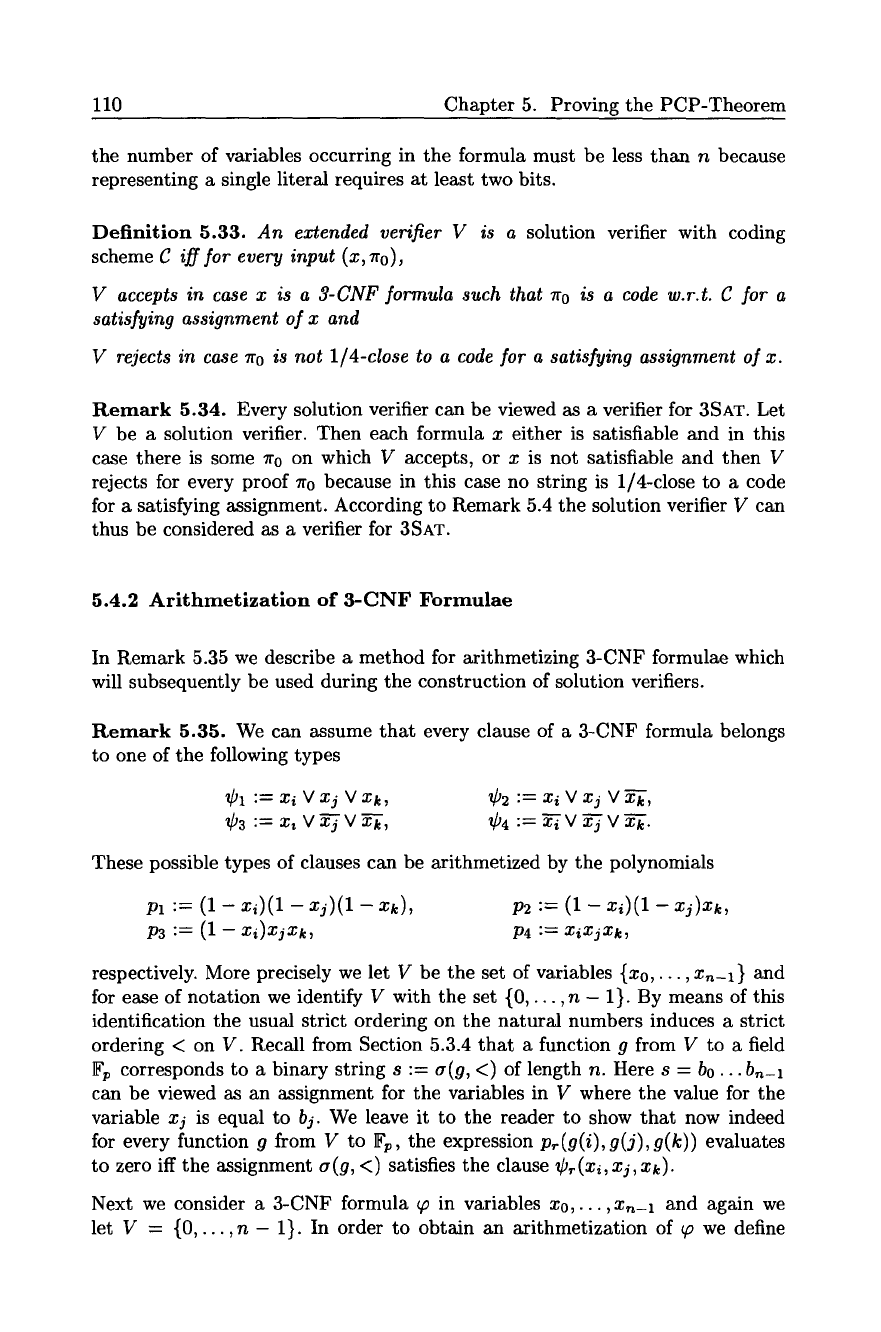
110 Chapter 5. Proving the PCP-Theorem
the number of variables occurring in the formula must be less than n because
representing a single literal requires at least two bits.
Definition 5.33. An extended verifier V is a solution verifier with coding
scheme C ifffor every input (x, Tro),
V accepts in case x is a 3-CNF formula such that 7to is a code w.r.t. C for a
satisfying assignment of x and
V rejects in case ro is not 1~4-close to a code for a satisfying assignment of x.
Remark 5.34. Every solution verifier can be viewed as a verifier for 3SAT. Let
V be a solution verifier. Then each formula x either is satisfiable and in this
case there is some ~r0 on which V accepts, or x is not satisfiable and then V
rejects for every proof 7to because in this case no string is 1/4-close to a code
for a satisfying assignment. According to Remark 5.4 the solution verifier V can
thus be considered as a verifier for 3SAT.
5.4.2 Arithmetization of 3-CNF Formulae
In Remark 5.35 we describe a method for arithmetizing 3-CNF formulae which
will subsequently be used during the construction of solution verifiers.
Remark 5.35. We can assume that every clause of a 3-CNF formula belongs
to one of the following types
r
:=
xi
V
xj
V
xk, r
:=
xi
V
xj
V
"~,
~3 := ~,
v~Tv~, r
:= ~v ~v~.
These possible types of clauses can be arithmetized by the polynomials
Pi
::
(1 - xi)(X - xj)(1 - xk), p2 := (1 - xi)(l - xj)xk,
PS := (1- x~)XjXk, P4 := xixjxk,
respectively. More precisely we let V be the set of variables {x0,..., xn-1} and
for ease of notation we identify V with the set {0,... ,n - 1}. By means of this
identification the usual strict ordering on the natural numbers induces a strict
ordering < on V. Recall from Section 5.3.4 that a function g from V to a field
Fp corresponds to a binary string s := a(g, <) of length n. Here s = b0... bn-1
can be viewed as an assignment for the variables in V where the value for the
variable xj is equal to bj. We leave it to the reader to show that now indeed
for every function g from Y to Fp, the expression pr(g(i),g(j),g(k)) evaluates
to zero iff the assignment a(g, <) satisfies the clause Cr(Xi, xj, Xk).
Next we consider a 3-CNF formula q0 in variables x0,..., xn-1 and again we
let V = {0,...,n - 1}. In order to obtain an arithmetization of qo we define

5.4. Efficient Solution Verifiers 111
indicator functions X1,...,X4 from V 3 to {0, 1} which correspond to the four
types of clauses and where for example
Xl(i,j,k)
is 1 iff ~ contains a clause
xi V xj V xk.
Then a function g from V to a field Fp corresponds to satisfying
assignment
s = a(g,
<) for qo iff we have for all r = 1,... ,4 and for all
(i,j,k)
in V 3
x~( i, j, k) . p~ (g( i), g(j), g( k ) ) = 0
(5.13)
Thus we can for example test whether a(g, <) is a satisfying assignment for
by testing whether for r = 1,... ,4, the function shown in equation (5.13) is
identically zero on V 3.
Note that the arithmetization by the polynomials Pl,-.. ,P4 as given in Re-
mark 5.35 differs from the more intuitive standard way of arithmetizing Boolean
formulae where for example the formulae ~ and x A y are arithmetized as 1 - x
and xy,
respectively.
5.4.3 An
(•3,
1)-Restricted Solution Verifier
In this section, an (n 3, 1)-restricted solution verifier with linear function coding
scheme will be constructed. As described in the previous section, we use the
vector
~(x) = ~5(xo,..., x,~-l)
= (xr( i, j, k ) . pr(xi, x3,
Xk ) )( i,j,k,r)EV3•
of length 4n 3 as an
arithmetization
of the 3-CNF formula ~o on n variables in
V = (x0,...,x,~-l}. Here and in the sequel we denote by [ml : m2] the set
(n E N : ml ~< n A n <~ m2} and we abbreviate the vector (x0,... ,xn-1) by x.
As usual, we identify a function g : V --~ F2 with a binary string of length n, and
hence with an assignment for a 3-CNF formula ~. Note that a satisfying assign-
ment of the 3-CNF formula ~ corresponds in a natural way to an assignment of
(Xo,..., xn-1)
for which the vector qS(Xo,..., xn-1) is zero.
Observation 5.36.
A 3-CNF formula ~ is satisfiable if and only if its arith-
metization ~(x) is zero for some x e ~2 .
Testing whether such a vector q~(x) is zero can be done by testing whether the
scalar product of qb(x) and a random vector v E F~2 n3 is zero. While
~(x) T. v = 0
whenever qS(x) = 0, it is nonzero with probability 89 whenever qS(x) # 0 as shown
in the following lemma:
Lemma 5.37.
Let 0 # z E F~2 , then Probv[zTv #
0] = 89
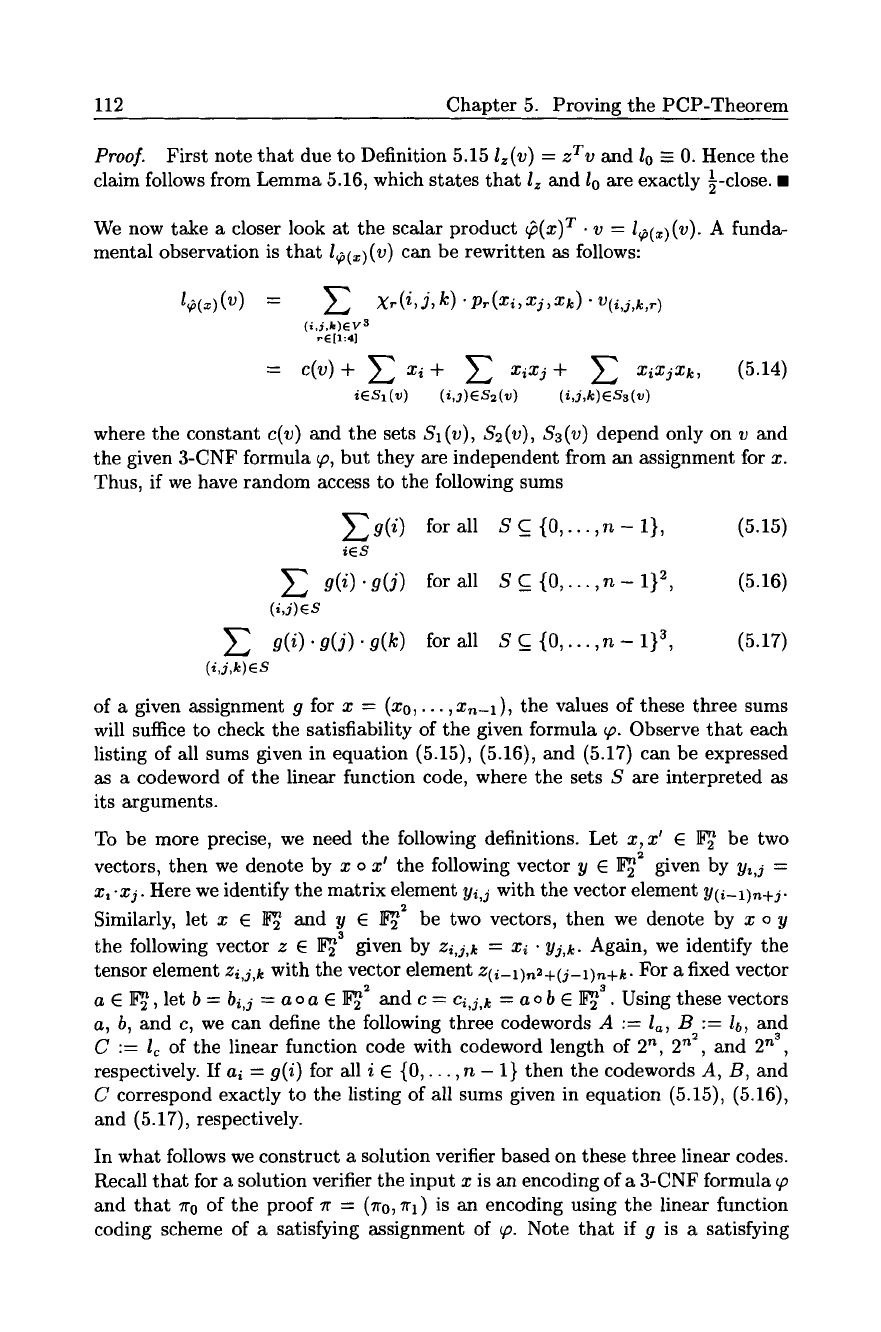
112 Chapter 5. Proving the PCP-Theorem
Proof.
First note that due to Definition 5.15
lz(v)
= zTv
and lo - O.
Hence the
claim follows from Lemma 5.16, which states that
lz and lo are
exactly 89 9
We now take a closer look at the scalar product
~(X) T 9 V ---- /~b(:c)(V)-
A funda-
mental observation is that l~(x)(v) can be rewritten as follows:
l~(x) (v) -- Z Xr (i,
J, k) . pr (xi, x j, xk) "
V(i,j,k,r)
(i,j,k)Ev s
.E[l:4]
= c(v)+
Z xi+ Z xixj+ Z xixjxk,
(5.14)
i~sl(v) (i,3)~s2(v) (i,j,k)~Ss(v)
where the constant c(v) and the sets Sx(v), S2(v), S3(v) depend only on v and
the given 3-CNF formula ~o, but they are independent from an assignment for x.
Thus, if we have random access to the following sums
Zg(i )
for all S C {O,...,n- 1}, (5.15)
iES
g(i).g(j)
for all S C {0,...,n- 1} a, (5.16)
(i,j)ES
Z g(i).g(j).g(k)
for all S C_ {O,...,n- 1} 3, (5.17)
(i,j,k)eS
of a given assignment g for
x = (xo,... ,xn-1),
the values of these three sums
will suffice to check the satisfiability of the given formula ~o. Observe that each
listing of all sums given in equation (5.15), (5.16), and (5.17) can be expressed
as a codeword of the linear function code, where the sets S are interpreted as
its arguments.
To be more precise, we need the following definitions. Let
x, x'
E F~2 be two
vectors, then we denote by x o x ~ the following vector y E F~2 2 given by
Yz,j =
x~ -xj. Here we identify the matrix element
yi,j
with the vector element
Y(i-1)n+j.
Similarly, let x E F~2 and y E F~2 2 be two vectors, then we denote by x o y
the following vector z e ~3 given by
zi,j,k
----
X i "Yg,k"
Again, we identify the
tensor element
zi,j,k
with the vector element
Z(i_l)n2+(j_l)n+k.
For
a fixed vector
a E F~2, let b =
bi,j = a o a E F~2 2 and c = Ci,j,k
= a o b E F~2 ~ . Using these vectors
a, b, and c, we can define the following three codewords A :-- l~, B :-- Ib, and
. . . 2
C :=
lc
of the hnear function code with codeword length of 2 n, 2 n , and 2 ~3,
respectively. If
ai = g(i)
for all i E {0,..., n - 1) then the codewords A, B, and
C correspond exactly to the listing of all sums given in equation (5.15), (5.16),
and (5.17), respectively.
In what follows we construct a solution verifier based on these three linear codes.
Recall that for a solution verifier the input x is an encoding of a 3-CNF formula ~o
and that 7r0 of the proof zr = (Tr0, zrl) is an encoding using the linear function
coding scheme of a satisfying assignment of qo. Note that if g is a satisfying
